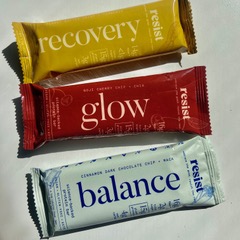A top question I get from my patients and in my Instagram DM’s is “What are your thoughts on X protein bar?” Unfortunately, Most of the time I have to be a bad news bear. I must inform them that their bar made with artificial sweeteners and an overwhelming load of added sugars is just a lonely carb with a good marketing budget. Bars that claim to contain tons of protein are usually higher in carbohydrates and fat; no wonder grocery shopping is so frustrating!
Finding a blood-sugar-friendly protein bar can be downright overwhelming. As a Registered Dietitian and Certified Diabetes Educator, I take protein bars quite seriously, both for myself and my patients. Protein bars are a convenient way to get satiating calories in a limited amount of time. They also help maintain stable blood sugar. But not every bar can achieve this blood-sugar balancing, appetite-satiating, solution. A Clif Bar, Luna, LARABAR, or Quest Bar isn’t going to do your insulin levels any good. Frankly, they may cause more issues for long term health.
A protein bar that is a solution? Resist Nutrition.
Resist Nutrition was able to create a bar designed for hormonal health, and is a far step above your everyday lonely carb energy bar. Their founder, Drew, received a diagnosis of insulin resistance and PCOS, a few years ago. PCOS is a hormone imbalance that affects 6-12% of women (and an even larger majority of my patient population!). Drew knew she must create a bar that would provide fuel on-the-go since the market was devoid of any! 
Enter Resist, one of the only bars on the market designed to support women’s health and support blood-sugar balance.
This is how a Registered Dietitian and Diabetes Educator picks a protein bar; let me walk you through the step-by-step process! Like any snack, first aim for real, whole-food ingredients first. Make sure to always read the label – a Whitness Nutrition must!
1.The Basics – Does it actually contain protein?
This may seem like an obvious recommendation, but it tends to be overlooked by many. Marketing tactics like fun flavors or pretty colors – hi, birthday cake protein bars– distract the consumer. The marketing techniques distract you from being aware of at the foundational basics. We want our protein bar to be, well, protein rich.
Use this hot tip! Compare the carb grams and protein grams on your label. If the protein content is higher than the net carbohydrates (total carb – total fiber), you’ve got a great bar!
Additionally, we want to look for a complete source of protein. This means all 9 essential amino acids are present in adequate amounts. Whey and casein powder are dairy-derived complete proteins, while pea protein is plant-based complete protein. Resist uses both pea protein and hemp protein in their bars. This makes Resist a protein-packed and plant-based protein bar option. Pea and hemp protein are easy to digest and won’t cause unwanted bloating or GI distress. Each Resist bar contains 15g of protein and has a 1:4 ratio of protein to net carbohydrates; ideal for blood sugar bliss!
2. Low in Net Carbohydrates
A protein bar is not an energy bar, and therefore should be low in net carbohydrates. This is to prevent the imminent blood sugar spike and fall of high carb choices. Net carbohydrates can be determined by subtracting any fiber or sugar alcohols present from the total carbohydrate content. We want this number to be low for a reason. Active carbs raise blood sugar and can cause unwanted spikes. Look for bars that not only contain more protein than net carbs, but are also rich in fiber!
High fiber options keep you full longer and have lower net carbohydrates. Fiber helps to slow down how fast carbs are digested. Fiber presence will affect how quickly sugar is absorbed into the blood. Aim for a bar that has 15% of more fiber, nothing less! A low carb, high protein bar will keep you full longer and keep blood sugar stable. The Resist protein bars are low glycemic and only contain 4g net carbs, thanks to their high fiber content. In fact, each bar contains 57% of your recommended daily fiber intake!
3. The Ingredients List
It wouldn’t be a Whitness Nutrition breakdown without a thorough review of the ingredients list! As I’ve previously mentioned, we want to look for real, whole food ingredients first. If the first ingredient of your bar is cane sugar, followed by vegetable oil and honey, it’s probably best to skip it. It’s especially important for balanced blood sugar to review the ingredients list. We want to avoid any ingredients that drive inflammation or rack up under added sugars. Remember; added sugars can be in the form of agave, dextrose, tapioca syrup; the list is long and tricky!
Look for a protein bar that is low in both added sugar and sugar alcohols. Avoid any inflammatory oils, which are all vegetable oils (canola, soybean, rapeseed, cottonseed).
Even better, look for a bar that contains blood-sugar supporting and hormone-balancing ingredients, like Resist.
- Maca: an adaptogen that has been shown to increase energy levels. It is also known to support hormone balance and act as a digestive aid. Maca supports adrenal function, a key player is hormone secretion and function.
- Cinnamon: this beloved spice is proven to improve insulin sensitivity and glucose control. This means cinnamon can help to lower blood sugar levels. Cinnamon can also help lower lipid levels, act as an anti-inflammatory and help prevent high blood pressure.
- Cacao: chocolate can support blood-sugar? Yes! Unsweetened cocoa, which can be used in dark chocolate, can help those with diabetes and PCOS. It increases insulin sensitivity and improves insulin resistance.
- Functional Fibers: Resist contains multiple sources of blood-supporting fibers. First, is chicory root fiber which is high in inulin. Inulin will help to metabolize carbohydrates and promotes sensitivity to insulin, or improve insulin resistance. Second, is prebiotic tapioca fiber which has shown to support insulin resistance as well as regulate metabolic health.
4. The Sweetener Source
Nobody wants a bland protein bar, but we also don’t need 15g of added sugar, either. I like to see a low-glycemic, naturally-sourced sweetener in packaged foods. This list would include honey, maple syrup, stevia, allulose or monk fruit. Resist bars use both Allulose and Monk Fruit to lightly sweeten their bars.
Allulose is a natural sweetener with a low-glycemic load that doesn’t cause spikes in insulin or blood sugar levels. In fact, allulose has actually been shown to help lower blood sugar, improve insulin resistance and help to decrease the risk of type 2 diabetes. Unlike sugar alcohols, allulose isn’t absorbed as readily in the gut. This means it won’t cause bloating or gas following digestion. In addition to using allulose in their bars, Resist also uses monk fruit, a naturally sourced sweetener. Monk fruit has shown to not raise blood sugar levels and is an excellent alternative for those with diabetes, hormone imbalances or insulin sensitivity.
While we’re on the topic of sugar and protein bars, let’s talk about artificial sweeteners and sugar alcohols.
Specifically, how artificial sweeteners can have the potential to negatively affect insulin resistance. Many of the leading protein bars on the market contain sugar alcohols and artificial sweeteners such as sucralose and Malitol, which can affect metabolism.
A recent study showed that sucralose, the equivalent to Splenda, can increase the insulin response to sugar. In fact, Splenda and its equivalents contain small amounts of dextrose. Dextrose can cause a small, but unwanted, insulin response. Being aware of dextrose is important for those with diabetes or with insulin resistance to be aware of. Artificial sweeteners can cause or worsen higher levels of insulin resistance. Our bodies are not able to process these artificial sugars as well as they are natural sweeteners such as allulose or monk fruit.
5. Support for hormone health
Remember, blood sugar balance is a key facet of hormone health. Insulin IS a hormone. I encourage all my patients follow a dietary lifestyle that is blood-sugar balanced. When there is an increase in low glycemic dietary intake, there is a dramatic improvement in the outcomes of insulin-resistance based diseases. These diseases include diabetes, PCOS, and a myriad of metabolic disease. Early management of insulin resistance can prevent a multiple of later onset disease. This isn’t just for those with diabetes, but also for early prevention!
Whitness Nutrition patients have routine blood work that includes fasting insulin, at least annually. Fasting insulin is more sensitive at insulin resistance prediction than a standard A1C. Standard A1C is used in mainstream conventional medicine protocols for diabetes diagnosis. Using these tests, I am able to provide disease-prevention education instead of reacting to a diagnosis that already exists. Resist Bars are at the top of the list for protein bar swaps due to their powerful tenants of blood sugar and hormone support.
“In fact, their full clinical trial showed that after consuming Resist bars, blood sugar was gradually raised over time and did not have a large drop or crash.”
There’s more to the protein bar aisle than fun flavors and marketing gimmicks.
Be aware, read the label, evaluate the ingredients, and consider your hormone health. Resist Nutrition bars are a great resource for easy blood sugar bliss support on the go. Resist Nutrition did create a delicious, functional line of protein bars that support our hormones & blood sugar.
Backed by science, Resist Protein bars are the perfect alternative to your sugar-laden, artificial ingredient filled protein bar. They’re vegan, gluten-free and keto-friendly. The bars are also free of sugar alcohols, dairy and soy. Try their three delicious flavors like Cinnamon Dark Chocolate Chip + Maca, which is my personal favorite! Follow this link to save or use code WHIT15 for 15% off your 1st order on Resist Nutrition.
Looking for more guidance on how to achieve blood sugar bliss and support insulin levels? Take a look into the Diabetes Master Plan. This fully self-paced course will help you navigate all things blood sugar, insulin resistance and diabetes!






I really enjoyed this breakdown on choosing protein bars for better blood sugar management. As someone in the protein bar industry, I know how tricky it can be to create a bar that balances protein, fiber, and low sugar content while still tasting good. Do you think consumers are becoming more aware of how certain ingredients impact blood sugar, or is there still a lot of confusion in the market? This was such a helpful guide for making smarter snack choices.
I really appreciate that, thank you! We love providing recommendations for patients because it IS confusing.